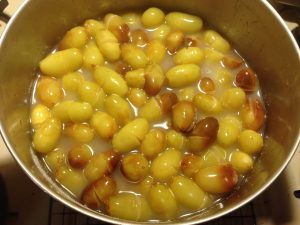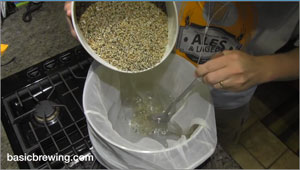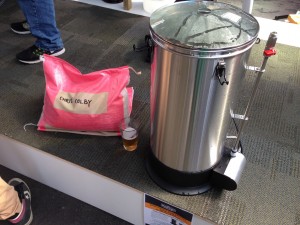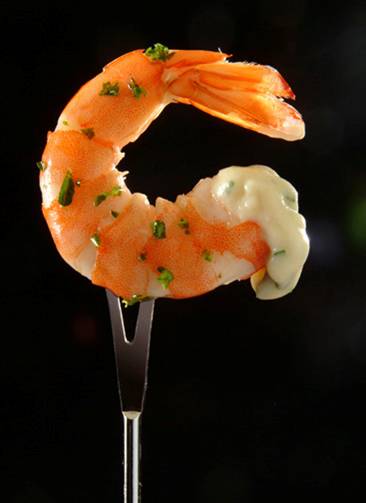Most homebrewers start by brewing ales. This is because it is not hard to find a cool room, or put a wet t-shirt over a carboy, and keep a fermenting ale in the proper temperature range. In contrast, for most people, holding 5.0-gallons (19 L) or more of beer at lager fermentation temperatures requires a fridge or freezer and an external thermostat.
If you’ve decided to take the plunge in lagers, your next choice is what to brew. Obviously, the type of lager beer you enjoy the most should be at the head of the list. For me, any of the amber lagers — including Vienna lagers, Märzens, Octoberfests, American amber lagers, and even rauchbiers — would be on my short list. On a recent episode on James Spencer’s podcast, Basic Brewing Radio, we discussed how to put together an amber lager recipe. In my opinion, the top three requirements for brewing a great amber lager are running an ordered fermentation; using fresh, high-quality ingredients; and, as always, being scrupulous about your cleaning and fermentation. Running an ordered fermentation involves pitching enough healthy yeast into properly aerated wort and holding the fermentation temperature steady.
On James’s show, we came up with two amber lager recipes that I’m sharing below. James has already brewed the first and a second brewer may try the second. (I’m going to be brewing a raspberry wheat beer from a previous show.) Here are the two recipes.
Third Man in the Fourth Zone Vienna Lager
Amber Lager (I), by Chris Colby
DESCRIPTION
This is a relatively dry, well-balanced amber lager. You could call it a Vienna lager, Märzen, or simply an amber lager.
INGREDIENTS (for 5.0 gallons/19 L)
Malts (for an OG. of 1.052 and 18 SRM)
7.5 lb. (3.4 kg) Vienna malt
2.5 lb. (1.1 kg) light Munich (8–10 °L)
2.0 oz. (57 g) black malt (dehusked preferred)
Hops (for 30 IBU)
2.5 oz. (71 g) Saaz hops (@3.2% AA)
Yeast (for FG 1.011 and 5.4% ABV)
lager yeast (your choice, slurry from 1.0-gallon/4 L yeast starter)
PROCEDURES
Mash in with 3.5 gallons (13 L) of water at 151 °F (66 °C) for a strike temperature of 140 °F (60 °C). Let mash rest at 140 °F (60 °C) for 15 minutes, then heat mash to 152 °F (67 °C). Stir as you heat. Raise temperature about 2 °F (~1 °C) per minute. Let rest at 152 °F (67 °C) for about 30 minutes, then mash out to 168 °F (76 °C). Recirculate and collect about 6.5 gallons (25 L) of wort. Boil for 90 minutes, to reduce wort volume to 5.0 (19 L) gallons. Add hops for final 60 minutes of the boil. Cool to fermentation temperature (which dependson the strain of yeast you have chosen). Aerate thoroughly and pitch yeast. Ferment until completion, allowing the temperature to rise to 60 °F (16 °C) at the end. After 3 days at 60 °F (16 °C), check to ensure that diacetyl is not detectable. Rack to a “secondary fermenter” or keg and store at refrigerator temperature for 4 weeks. Taste test and begin serving if the beer is no longer “green.”
Backyard Cookout Amber Lager
Amber Lager (II)
DESCRIPTION
This is a full-bodied amber lager, in the style of many American amber lagers. It’s balanced and “quaffable,” as they say.
INGREDIENTS (for 5.0 gallons/19 L)
Malts (for an OG. of 1.052 and 23 SRM)
5.0 lb. (2.3 kg) 2-row pale malt or Pilsner malt
4.0 lb. (1.8 kg) light Munich (8–10 °L)
6.0 oz. (170 g) crystal 40 °L
3.0 oz. (90 g) crystal 60 °L
2.0 oz. (57 g) black malt (dehusked preferred)
Hops (for 26 IBU)
any relatively neutral strain of hops for bittering
(for example 0.54 oz./15 g of Magnum at 13% AA)
0.25 oz. (7 g) any aroma hop without a strong varietal characteristic for aroma
Yeast (for FG 1.013 and 5.0% ABV)
lager yeast (your choice, slurry from 1.0-gallon/4 L yeast starter)
PROCEDURES
Mash in with 3.3 gallons (12 L) of water at 163 °F (73 °C) for a strike temperature of 152 °F (67 °C). Let the mash rest for 45 minutes. Mash out to 168 °F (76 °C). Recirculate and collect about 6.3 gallons (24 L) of wort. Boil for about 75 minutes, to reduce wort volume to 5.0 gallons (19 L). Add bittering hops for final 60 minutes of the boil. Add aroma hops at knockout. Cool to fermentation temperature (which depends on your yeast strain). Aerate thoroughly and pitch yeast. Ferment until completion, allowing the temperature to rise to 60 °F (16 °C) at the end. After 3 days at 60 °F (16 °C), check that diacetyl is gone. Rack to a “secondary fermenter” or keg and store at refrigerator temperature for 4 weeks. Taste test and begin serving if the beer is no longer “green.”
Both of these recipes were formulated by James and I, and were not brewed at the time of our discussion. (They will be soon. And, they’re both very similar to two amber lagers in my recipe book, The HomeBrew Recipe Bible.) For yet another amber lager recipe, see also my Schell’s Firebrick clone. Firebrick is a beer I seek out whenever I’m in the upper midwest. It’s a wonderfully balanced beer, in my opinion.











Recent Comments